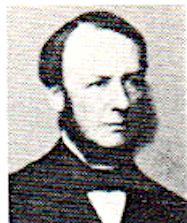
Philip Charles Hardwick was born in Westminster, Middlesex [now London], England on 12 September 1822. Both his father, Philip Hardwick (1792-1870) and his grandfather, Thomas Hardwick (1752-1825) were architects. He trained in the office of Edward Blore (1787-1879) and of his father in London. He subsequently worked both independently and with his father, although they were not partners. Like his father, much of his work was in the City of London where he designed a many banks and banking offices. He also designed a number of public schools, notably Charterhouse in Godalming, Surrey and St. Edmunds in Canterbury, Kent; and several country houses. The building for which he is probably best known is Great Hall of London's Euston railway station.
In 1852 he took over his father's practice. He was Architect to the Bank of England, St. Bartholowmew's Hospital, the Merchant Taylor's Company, Greenwich Hospital, and Charterhouse School. He was elected a Fellow of the Royal Institute of British Architects (FRIBA) in 1850. Between 1848 and 1854 he exhibited regularly at the Royal Academy in London.
Arthur William Blomfield (1829-1899) was one of Philip Charles Hardwick's pupils.
Hardwick died at his home, 2 Hereford Gardens, Park Lane, London on 27 January 1892
Works by Philip Charles Hardwick included banks for Jones Lloyd & Co., Lothbury (1843); restoration of St Nicholas church, Durweston, Dorset (1847); Aldermaston Court, Berkshire (1848-51); Durham Town Hall (1849-51); school at Little Brington, Northamptonshire (1850); completion of Adare Manor, in Adare, County Limerick, Ireland (1850–62); Royal Freemasons' School in Wandsworth (1851); restoration of St Mary's Church, Lambeth (1851–52); Great Western Royal Hotel, Paddington station (1851–53); College of St. Columba, Dublin (1852); Chapel of Ease of St Saviour, Shotton, County Durham (1852–54); restoration of St. Nicholas, Elstree, Hertfordshire (1853); restoration of tower at St. Martin, Birmingham (1853-55); Ship Hotel, Greenwich (1853-58); London and Australian Bank and Robarts Bank, London (1854); Clergy Orphans Schools in Canterbury, Kent (1854); St John's Church, Deptford (1855); All Saints, Haggerston Road, London (1855-56); The Abbots in Sompting, Sussex (1856); Riding School, Knightsbridge for the Duke of Wellington (1856-57); St John's Cathedral, Limerick, Ireland (1856–61); Adhurst St Mary house, Petersfield, Hampshire (1858); All Saints, Aston Ubthorpe (1859-60); rebuilding of the Smithfield frontage of St. Bartholomew's Horpital, London (1861); new wings at the Greenwich Hospital School (1861-62); chapel at Hartham Park, Wiltshire (1862); Almshouses, Newland, near Malvern, Worcestershire (1862-63); All Saints, Aldershot (1863); Madresfield Court, Worcestershire (1863-65); Rendcomb House, Rendcomb, Gloucestershire (1864-67); Barclay & Bevan's Bank, Lombard Street, London (1864); Union Bank, London (1865); Charterhouse School, Godalming, Surrey (1865-72); Crown Bank, Norwich, Norfolk (1866); and St Edmund's School Canterbury, Kent (1860s).
_____
See also:
Historic England - 79 entries relating to Philip Hardwick and Philip Charles Hardwick [Link below]
British Listed Buildings - 63 listed buildings by Philip Hardwick and Philip Charles Hardwick [Link below]
RIBApix! - nearly 160 images of buildings designed by Philip Hardwick and Philip Charles Hardwick [Link below]
Cornforth, John. ‘Adare Manor, Co. Limerick’. Country Life vol. 146, 29 May 1969 pp. 1366-1369
Directory of British Architects 1834-1914. Compiled by Antonia Brodie, et al. Volume 1: A-K. London; New York: British Architectural Library, Royal Institute of British Architects/Continuum, 2001
Girouard, Mark. The Victorian Country House. New Haven and London: Yale University Press, revised and enlarged edition, 1979
Hobhouse. Hermione. ‘Philip and Philip Charles Hardwick’ in architectural dynasty’. in Seven Victorian architects’, edited by Jane Fawcett. London: Thames & Hudson, 1976 pp.32-49, 139-141, 151-152
‘Obituary’. The Builder vol. 62, 6 February 1892 p. 108
‘Obituary’. The Builder vol. 62, 13 February 1892 p. 120
‘Obituary’. Illustrated London News 19 March 1892 p. 372
‘Obituary’. Royal Institute of British Architects Proceedings (new series) vol. 8, 1892 pp. 174-175
‘Obituary’. The Times 30 January 1892 p. 7